University Design IT: Reflection on Weekly Lectures and Activities
VerifiedAdded on 2020/03/16
|12
|3293
|130
Essay
AI Summary
This reflective essay provides a comprehensive overview of a student's learning journey in a Design IT course spanning twelve weeks. The student reflects on various topics, including design thinking, innovation, and diffusion theories. The essay details weekly lectures covering needs analysis, prototyping, design theory, problem-solving, journey mapping, data collection, prototyping, launch strategies, entrepreneurial marketing, and fundraising. The student discusses practical activities, such as workshops on prototyping and brainstorming, and analyzes their understanding of key concepts like design methodologies, marketing campaigns, and fundraising strategies. The essay highlights the student's personal growth and the application of learned concepts in real-world scenarios, concluding with a positive assessment of the course's impact on their ability to solve design-related complexities and prepare for future projects.
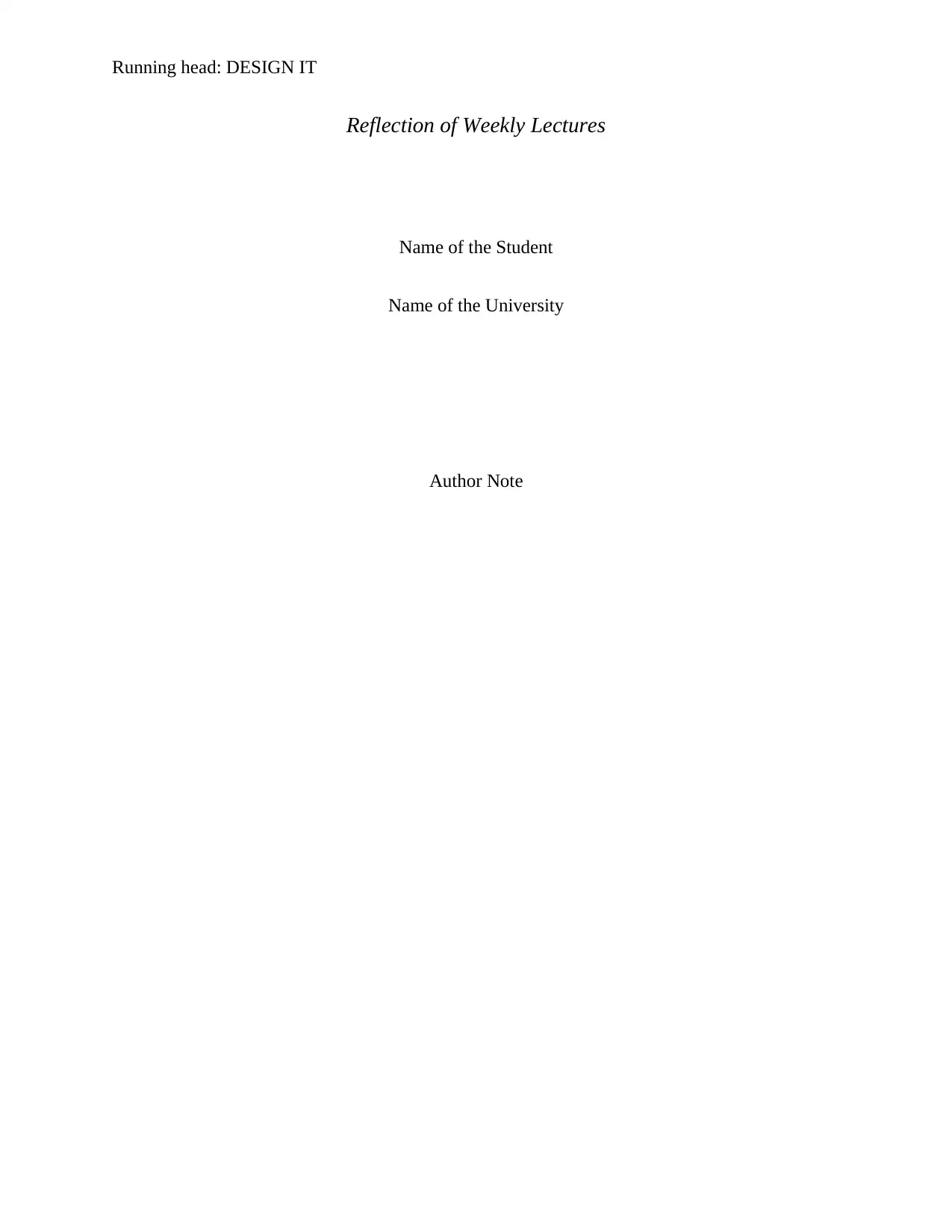
Running head: DESIGN IT
Reflection of Weekly Lectures
Name of the Student
Name of the University
Author Note
Reflection of Weekly Lectures
Name of the Student
Name of the University
Author Note
Paraphrase This Document
Need a fresh take? Get an instant paraphrase of this document with our AI Paraphraser
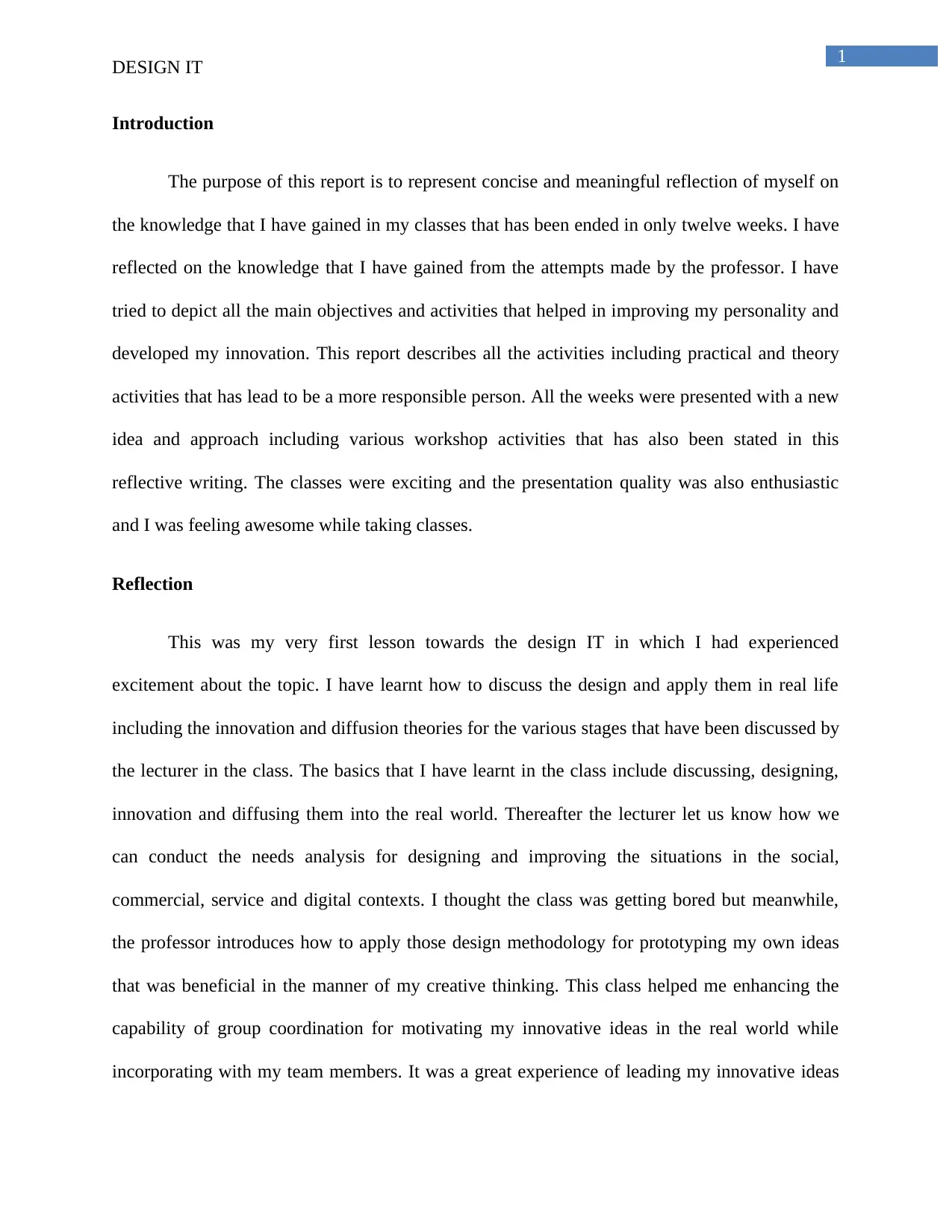
1
DESIGN IT
Introduction
The purpose of this report is to represent concise and meaningful reflection of myself on
the knowledge that I have gained in my classes that has been ended in only twelve weeks. I have
reflected on the knowledge that I have gained from the attempts made by the professor. I have
tried to depict all the main objectives and activities that helped in improving my personality and
developed my innovation. This report describes all the activities including practical and theory
activities that has lead to be a more responsible person. All the weeks were presented with a new
idea and approach including various workshop activities that has also been stated in this
reflective writing. The classes were exciting and the presentation quality was also enthusiastic
and I was feeling awesome while taking classes.
Reflection
This was my very first lesson towards the design IT in which I had experienced
excitement about the topic. I have learnt how to discuss the design and apply them in real life
including the innovation and diffusion theories for the various stages that have been discussed by
the lecturer in the class. The basics that I have learnt in the class include discussing, designing,
innovation and diffusing them into the real world. Thereafter the lecturer let us know how we
can conduct the needs analysis for designing and improving the situations in the social,
commercial, service and digital contexts. I thought the class was getting bored but meanwhile,
the professor introduces how to apply those design methodology for prototyping my own ideas
that was beneficial in the manner of my creative thinking. This class helped me enhancing the
capability of group coordination for motivating my innovative ideas in the real world while
incorporating with my team members. It was a great experience of leading my innovative ideas
DESIGN IT
Introduction
The purpose of this report is to represent concise and meaningful reflection of myself on
the knowledge that I have gained in my classes that has been ended in only twelve weeks. I have
reflected on the knowledge that I have gained from the attempts made by the professor. I have
tried to depict all the main objectives and activities that helped in improving my personality and
developed my innovation. This report describes all the activities including practical and theory
activities that has lead to be a more responsible person. All the weeks were presented with a new
idea and approach including various workshop activities that has also been stated in this
reflective writing. The classes were exciting and the presentation quality was also enthusiastic
and I was feeling awesome while taking classes.
Reflection
This was my very first lesson towards the design IT in which I had experienced
excitement about the topic. I have learnt how to discuss the design and apply them in real life
including the innovation and diffusion theories for the various stages that have been discussed by
the lecturer in the class. The basics that I have learnt in the class include discussing, designing,
innovation and diffusing them into the real world. Thereafter the lecturer let us know how we
can conduct the needs analysis for designing and improving the situations in the social,
commercial, service and digital contexts. I thought the class was getting bored but meanwhile,
the professor introduces how to apply those design methodology for prototyping my own ideas
that was beneficial in the manner of my creative thinking. This class helped me enhancing the
capability of group coordination for motivating my innovative ideas in the real world while
incorporating with my team members. It was a great experience of leading my innovative ideas
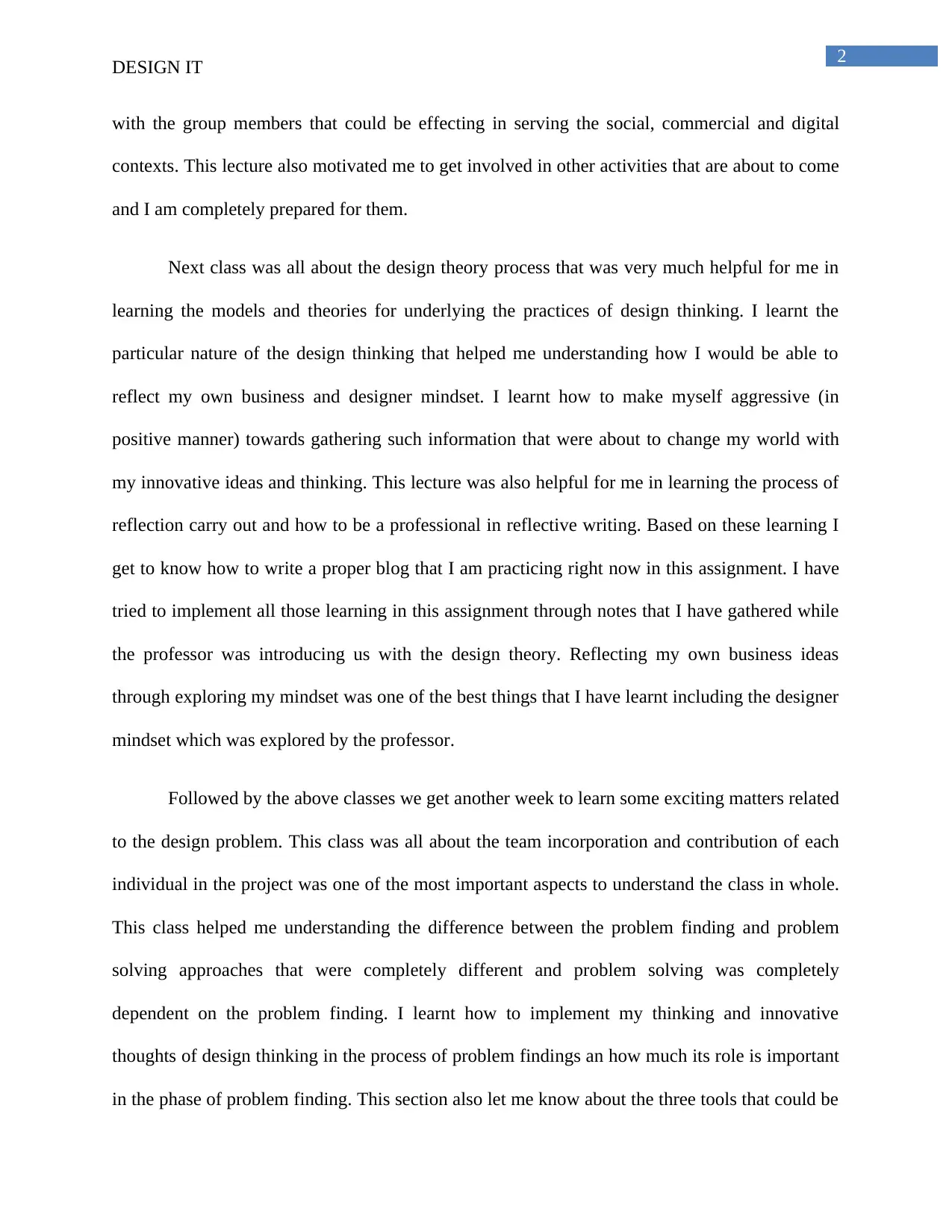
2
DESIGN IT
with the group members that could be effecting in serving the social, commercial and digital
contexts. This lecture also motivated me to get involved in other activities that are about to come
and I am completely prepared for them.
Next class was all about the design theory process that was very much helpful for me in
learning the models and theories for underlying the practices of design thinking. I learnt the
particular nature of the design thinking that helped me understanding how I would be able to
reflect my own business and designer mindset. I learnt how to make myself aggressive (in
positive manner) towards gathering such information that were about to change my world with
my innovative ideas and thinking. This lecture was also helpful for me in learning the process of
reflection carry out and how to be a professional in reflective writing. Based on these learning I
get to know how to write a proper blog that I am practicing right now in this assignment. I have
tried to implement all those learning in this assignment through notes that I have gathered while
the professor was introducing us with the design theory. Reflecting my own business ideas
through exploring my mindset was one of the best things that I have learnt including the designer
mindset which was explored by the professor.
Followed by the above classes we get another week to learn some exciting matters related
to the design problem. This class was all about the team incorporation and contribution of each
individual in the project was one of the most important aspects to understand the class in whole.
This class helped me understanding the difference between the problem finding and problem
solving approaches that were completely different and problem solving was completely
dependent on the problem finding. I learnt how to implement my thinking and innovative
thoughts of design thinking in the process of problem findings an how much its role is important
in the phase of problem finding. This section also let me know about the three tools that could be
DESIGN IT
with the group members that could be effecting in serving the social, commercial and digital
contexts. This lecture also motivated me to get involved in other activities that are about to come
and I am completely prepared for them.
Next class was all about the design theory process that was very much helpful for me in
learning the models and theories for underlying the practices of design thinking. I learnt the
particular nature of the design thinking that helped me understanding how I would be able to
reflect my own business and designer mindset. I learnt how to make myself aggressive (in
positive manner) towards gathering such information that were about to change my world with
my innovative ideas and thinking. This lecture was also helpful for me in learning the process of
reflection carry out and how to be a professional in reflective writing. Based on these learning I
get to know how to write a proper blog that I am practicing right now in this assignment. I have
tried to implement all those learning in this assignment through notes that I have gathered while
the professor was introducing us with the design theory. Reflecting my own business ideas
through exploring my mindset was one of the best things that I have learnt including the designer
mindset which was explored by the professor.
Followed by the above classes we get another week to learn some exciting matters related
to the design problem. This class was all about the team incorporation and contribution of each
individual in the project was one of the most important aspects to understand the class in whole.
This class helped me understanding the difference between the problem finding and problem
solving approaches that were completely different and problem solving was completely
dependent on the problem finding. I learnt how to implement my thinking and innovative
thoughts of design thinking in the process of problem findings an how much its role is important
in the phase of problem finding. This section also let me know about the three tools that could be
⊘ This is a preview!⊘
Do you want full access?
Subscribe today to unlock all pages.

Trusted by 1+ million students worldwide
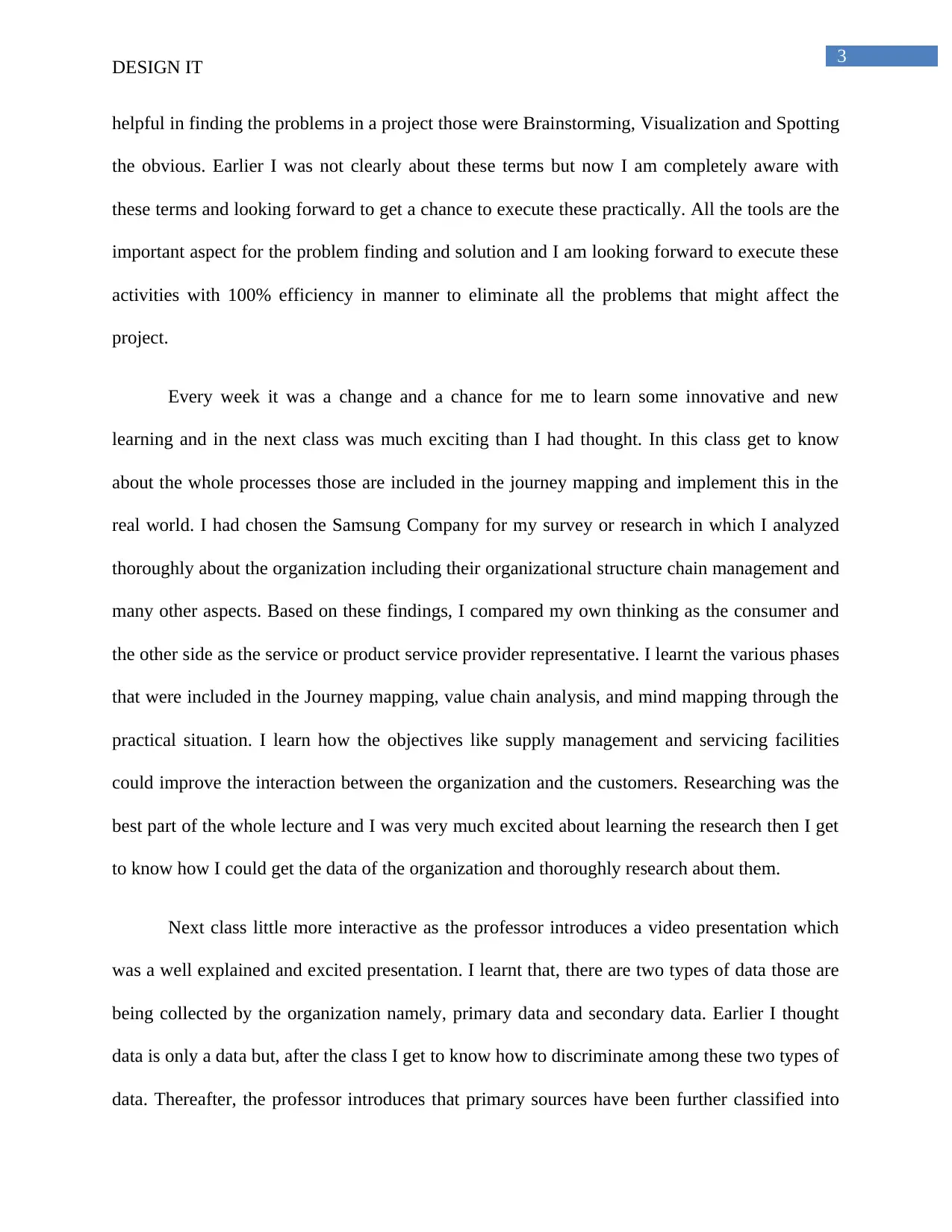
3
DESIGN IT
helpful in finding the problems in a project those were Brainstorming, Visualization and Spotting
the obvious. Earlier I was not clearly about these terms but now I am completely aware with
these terms and looking forward to get a chance to execute these practically. All the tools are the
important aspect for the problem finding and solution and I am looking forward to execute these
activities with 100% efficiency in manner to eliminate all the problems that might affect the
project.
Every week it was a change and a chance for me to learn some innovative and new
learning and in the next class was much exciting than I had thought. In this class get to know
about the whole processes those are included in the journey mapping and implement this in the
real world. I had chosen the Samsung Company for my survey or research in which I analyzed
thoroughly about the organization including their organizational structure chain management and
many other aspects. Based on these findings, I compared my own thinking as the consumer and
the other side as the service or product service provider representative. I learnt the various phases
that were included in the Journey mapping, value chain analysis, and mind mapping through the
practical situation. I learn how the objectives like supply management and servicing facilities
could improve the interaction between the organization and the customers. Researching was the
best part of the whole lecture and I was very much excited about learning the research then I get
to know how I could get the data of the organization and thoroughly research about them.
Next class little more interactive as the professor introduces a video presentation which
was a well explained and excited presentation. I learnt that, there are two types of data those are
being collected by the organization namely, primary data and secondary data. Earlier I thought
data is only a data but, after the class I get to know how to discriminate among these two types of
data. Thereafter, the professor introduces that primary sources have been further classified into
DESIGN IT
helpful in finding the problems in a project those were Brainstorming, Visualization and Spotting
the obvious. Earlier I was not clearly about these terms but now I am completely aware with
these terms and looking forward to get a chance to execute these practically. All the tools are the
important aspect for the problem finding and solution and I am looking forward to execute these
activities with 100% efficiency in manner to eliminate all the problems that might affect the
project.
Every week it was a change and a chance for me to learn some innovative and new
learning and in the next class was much exciting than I had thought. In this class get to know
about the whole processes those are included in the journey mapping and implement this in the
real world. I had chosen the Samsung Company for my survey or research in which I analyzed
thoroughly about the organization including their organizational structure chain management and
many other aspects. Based on these findings, I compared my own thinking as the consumer and
the other side as the service or product service provider representative. I learnt the various phases
that were included in the Journey mapping, value chain analysis, and mind mapping through the
practical situation. I learn how the objectives like supply management and servicing facilities
could improve the interaction between the organization and the customers. Researching was the
best part of the whole lecture and I was very much excited about learning the research then I get
to know how I could get the data of the organization and thoroughly research about them.
Next class little more interactive as the professor introduces a video presentation which
was a well explained and excited presentation. I learnt that, there are two types of data those are
being collected by the organization namely, primary data and secondary data. Earlier I thought
data is only a data but, after the class I get to know how to discriminate among these two types of
data. Thereafter, the professor introduces that primary sources have been further classified into
Paraphrase This Document
Need a fresh take? Get an instant paraphrase of this document with our AI Paraphraser
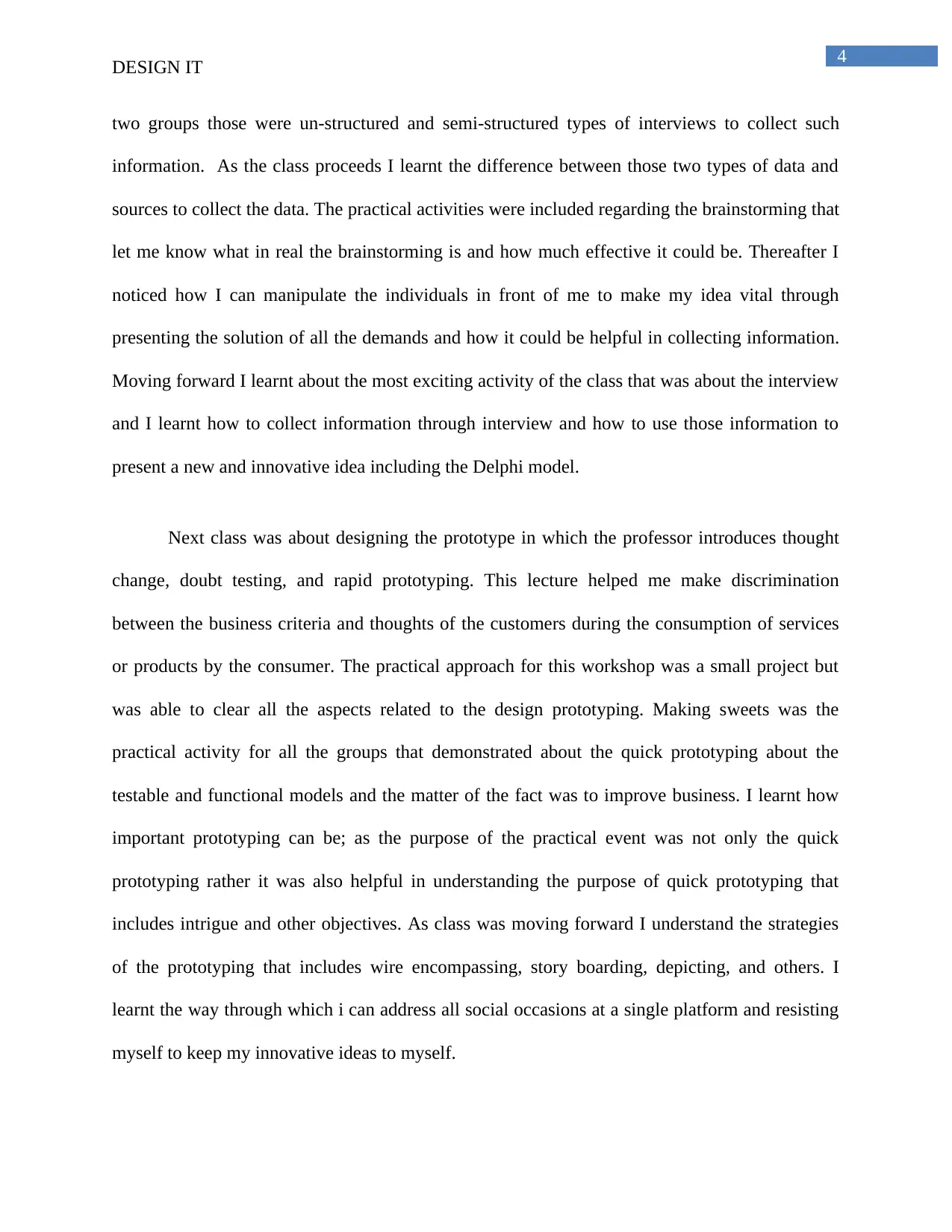
4
DESIGN IT
two groups those were un-structured and semi-structured types of interviews to collect such
information. As the class proceeds I learnt the difference between those two types of data and
sources to collect the data. The practical activities were included regarding the brainstorming that
let me know what in real the brainstorming is and how much effective it could be. Thereafter I
noticed how I can manipulate the individuals in front of me to make my idea vital through
presenting the solution of all the demands and how it could be helpful in collecting information.
Moving forward I learnt about the most exciting activity of the class that was about the interview
and I learnt how to collect information through interview and how to use those information to
present a new and innovative idea including the Delphi model.
Next class was about designing the prototype in which the professor introduces thought
change, doubt testing, and rapid prototyping. This lecture helped me make discrimination
between the business criteria and thoughts of the customers during the consumption of services
or products by the consumer. The practical approach for this workshop was a small project but
was able to clear all the aspects related to the design prototyping. Making sweets was the
practical activity for all the groups that demonstrated about the quick prototyping about the
testable and functional models and the matter of the fact was to improve business. I learnt how
important prototyping can be; as the purpose of the practical event was not only the quick
prototyping rather it was also helpful in understanding the purpose of quick prototyping that
includes intrigue and other objectives. As class was moving forward I understand the strategies
of the prototyping that includes wire encompassing, story boarding, depicting, and others. I
learnt the way through which i can address all social occasions at a single platform and resisting
myself to keep my innovative ideas to myself.
DESIGN IT
two groups those were un-structured and semi-structured types of interviews to collect such
information. As the class proceeds I learnt the difference between those two types of data and
sources to collect the data. The practical activities were included regarding the brainstorming that
let me know what in real the brainstorming is and how much effective it could be. Thereafter I
noticed how I can manipulate the individuals in front of me to make my idea vital through
presenting the solution of all the demands and how it could be helpful in collecting information.
Moving forward I learnt about the most exciting activity of the class that was about the interview
and I learnt how to collect information through interview and how to use those information to
present a new and innovative idea including the Delphi model.
Next class was about designing the prototype in which the professor introduces thought
change, doubt testing, and rapid prototyping. This lecture helped me make discrimination
between the business criteria and thoughts of the customers during the consumption of services
or products by the consumer. The practical approach for this workshop was a small project but
was able to clear all the aspects related to the design prototyping. Making sweets was the
practical activity for all the groups that demonstrated about the quick prototyping about the
testable and functional models and the matter of the fact was to improve business. I learnt how
important prototyping can be; as the purpose of the practical event was not only the quick
prototyping rather it was also helpful in understanding the purpose of quick prototyping that
includes intrigue and other objectives. As class was moving forward I understand the strategies
of the prototyping that includes wire encompassing, story boarding, depicting, and others. I
learnt the way through which i can address all social occasions at a single platform and resisting
myself to keep my innovative ideas to myself.
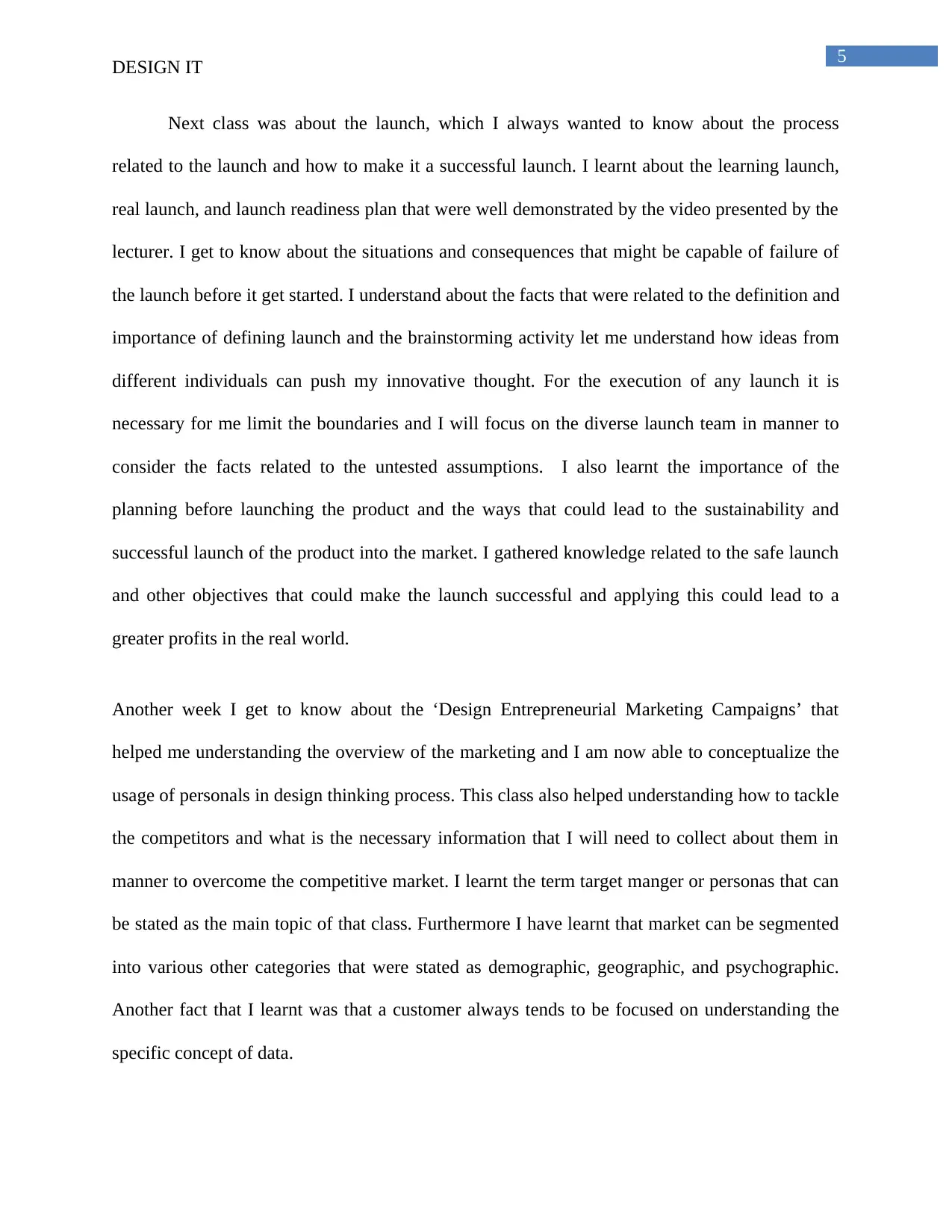
5
DESIGN IT
Next class was about the launch, which I always wanted to know about the process
related to the launch and how to make it a successful launch. I learnt about the learning launch,
real launch, and launch readiness plan that were well demonstrated by the video presented by the
lecturer. I get to know about the situations and consequences that might be capable of failure of
the launch before it get started. I understand about the facts that were related to the definition and
importance of defining launch and the brainstorming activity let me understand how ideas from
different individuals can push my innovative thought. For the execution of any launch it is
necessary for me limit the boundaries and I will focus on the diverse launch team in manner to
consider the facts related to the untested assumptions. “I also learnt the importance of the
planning before launching the product and the ways that could lead to the sustainability and
successful launch of the product into the market. I gathered knowledge related to the safe launch
and other objectives that could make the launch successful and applying this could lead to a
greater profits in the real world.”
Another week I get to know about the ‘Design Entrepreneurial Marketing Campaigns’ that
helped me understanding the overview of the marketing and I am now able to conceptualize the
usage of personals in design thinking process. This class also helped understanding how to tackle
the competitors and what is the necessary information that I will need to collect about them in
manner to overcome the competitive market. I learnt the term target manger or personas that can
be stated as the main topic of that class. Furthermore I have learnt that market can be segmented
into various other categories that were stated as demographic, geographic, and psychographic.
Another fact that I learnt was that a customer always tends to be focused on understanding the
specific concept of data.
DESIGN IT
Next class was about the launch, which I always wanted to know about the process
related to the launch and how to make it a successful launch. I learnt about the learning launch,
real launch, and launch readiness plan that were well demonstrated by the video presented by the
lecturer. I get to know about the situations and consequences that might be capable of failure of
the launch before it get started. I understand about the facts that were related to the definition and
importance of defining launch and the brainstorming activity let me understand how ideas from
different individuals can push my innovative thought. For the execution of any launch it is
necessary for me limit the boundaries and I will focus on the diverse launch team in manner to
consider the facts related to the untested assumptions. “I also learnt the importance of the
planning before launching the product and the ways that could lead to the sustainability and
successful launch of the product into the market. I gathered knowledge related to the safe launch
and other objectives that could make the launch successful and applying this could lead to a
greater profits in the real world.”
Another week I get to know about the ‘Design Entrepreneurial Marketing Campaigns’ that
helped me understanding the overview of the marketing and I am now able to conceptualize the
usage of personals in design thinking process. This class also helped understanding how to tackle
the competitors and what is the necessary information that I will need to collect about them in
manner to overcome the competitive market. I learnt the term target manger or personas that can
be stated as the main topic of that class. Furthermore I have learnt that market can be segmented
into various other categories that were stated as demographic, geographic, and psychographic.
Another fact that I learnt was that a customer always tends to be focused on understanding the
specific concept of data.
⊘ This is a preview!⊘
Do you want full access?
Subscribe today to unlock all pages.

Trusted by 1+ million students worldwide
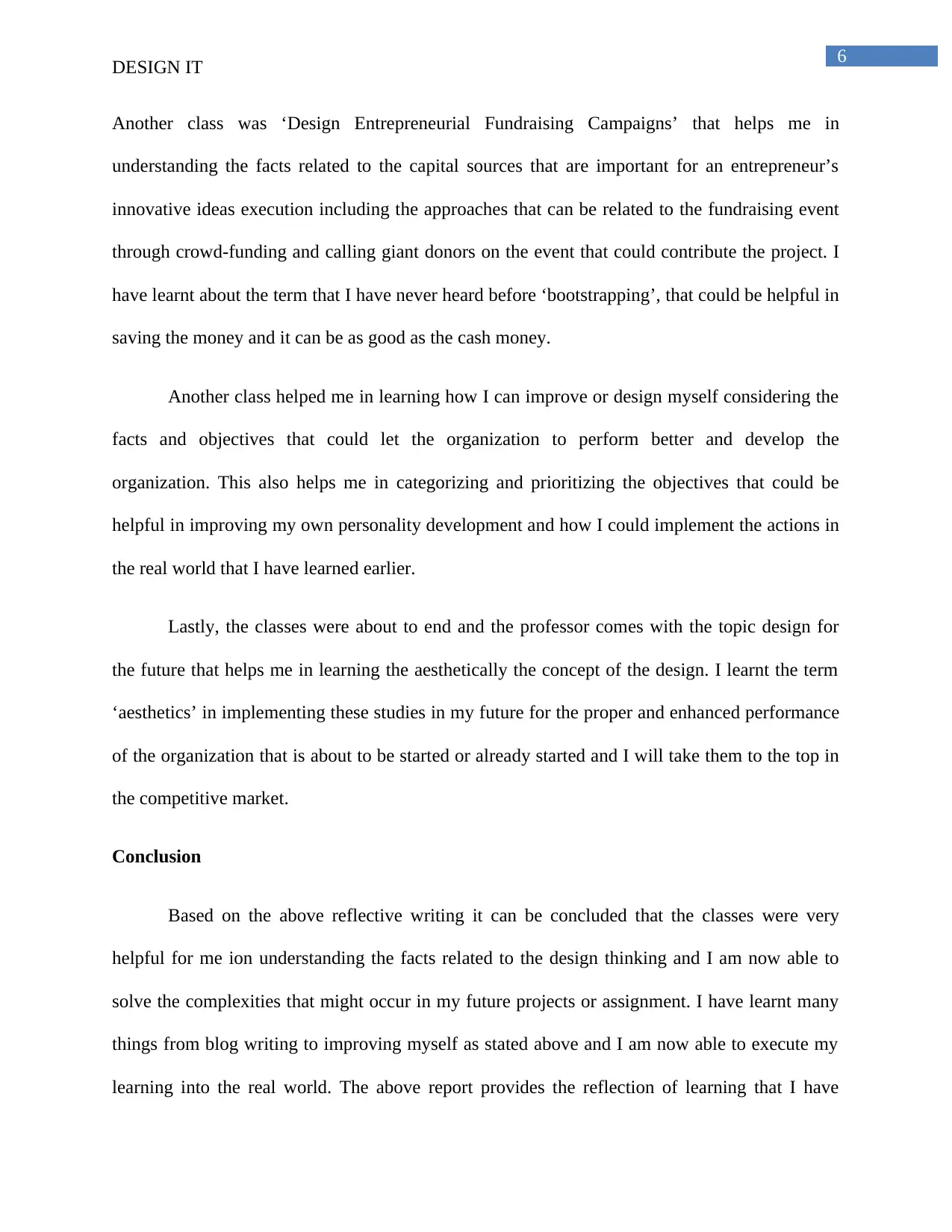
6
DESIGN IT
Another class was ‘Design Entrepreneurial Fundraising Campaigns’ that helps me in
understanding the facts related to the capital sources that are important for an entrepreneur’s
innovative ideas execution including the approaches that can be related to the fundraising event
through crowd-funding and calling giant donors on the event that could contribute the project. I
have learnt about the term that I have never heard before ‘bootstrapping’, that could be helpful in
saving the money and it can be as good as the cash money.
Another class helped me in learning how I can improve or design myself considering the
facts and objectives that could let the organization to perform better and develop the
organization. This also helps me in categorizing and prioritizing the objectives that could be
helpful in improving my own personality development and how I could implement the actions in
the real world that I have learned earlier.
Lastly, the classes were about to end and the professor comes with the topic design for
the future that helps me in learning the aesthetically the concept of the design. I learnt the term
‘aesthetics’ in implementing these studies in my future for the proper and enhanced performance
of the organization that is about to be started or already started and I will take them to the top in
the competitive market.
Conclusion
Based on the above reflective writing it can be concluded that the classes were very
helpful for me ion understanding the facts related to the design thinking and I am now able to
solve the complexities that might occur in my future projects or assignment. I have learnt many
things from blog writing to improving myself as stated above and I am now able to execute my
learning into the real world. The above report provides the reflection of learning that I have
DESIGN IT
Another class was ‘Design Entrepreneurial Fundraising Campaigns’ that helps me in
understanding the facts related to the capital sources that are important for an entrepreneur’s
innovative ideas execution including the approaches that can be related to the fundraising event
through crowd-funding and calling giant donors on the event that could contribute the project. I
have learnt about the term that I have never heard before ‘bootstrapping’, that could be helpful in
saving the money and it can be as good as the cash money.
Another class helped me in learning how I can improve or design myself considering the
facts and objectives that could let the organization to perform better and develop the
organization. This also helps me in categorizing and prioritizing the objectives that could be
helpful in improving my own personality development and how I could implement the actions in
the real world that I have learned earlier.
Lastly, the classes were about to end and the professor comes with the topic design for
the future that helps me in learning the aesthetically the concept of the design. I learnt the term
‘aesthetics’ in implementing these studies in my future for the proper and enhanced performance
of the organization that is about to be started or already started and I will take them to the top in
the competitive market.
Conclusion
Based on the above reflective writing it can be concluded that the classes were very
helpful for me ion understanding the facts related to the design thinking and I am now able to
solve the complexities that might occur in my future projects or assignment. I have learnt many
things from blog writing to improving myself as stated above and I am now able to execute my
learning into the real world. The above report provides the reflection of learning that I have
Paraphrase This Document
Need a fresh take? Get an instant paraphrase of this document with our AI Paraphraser
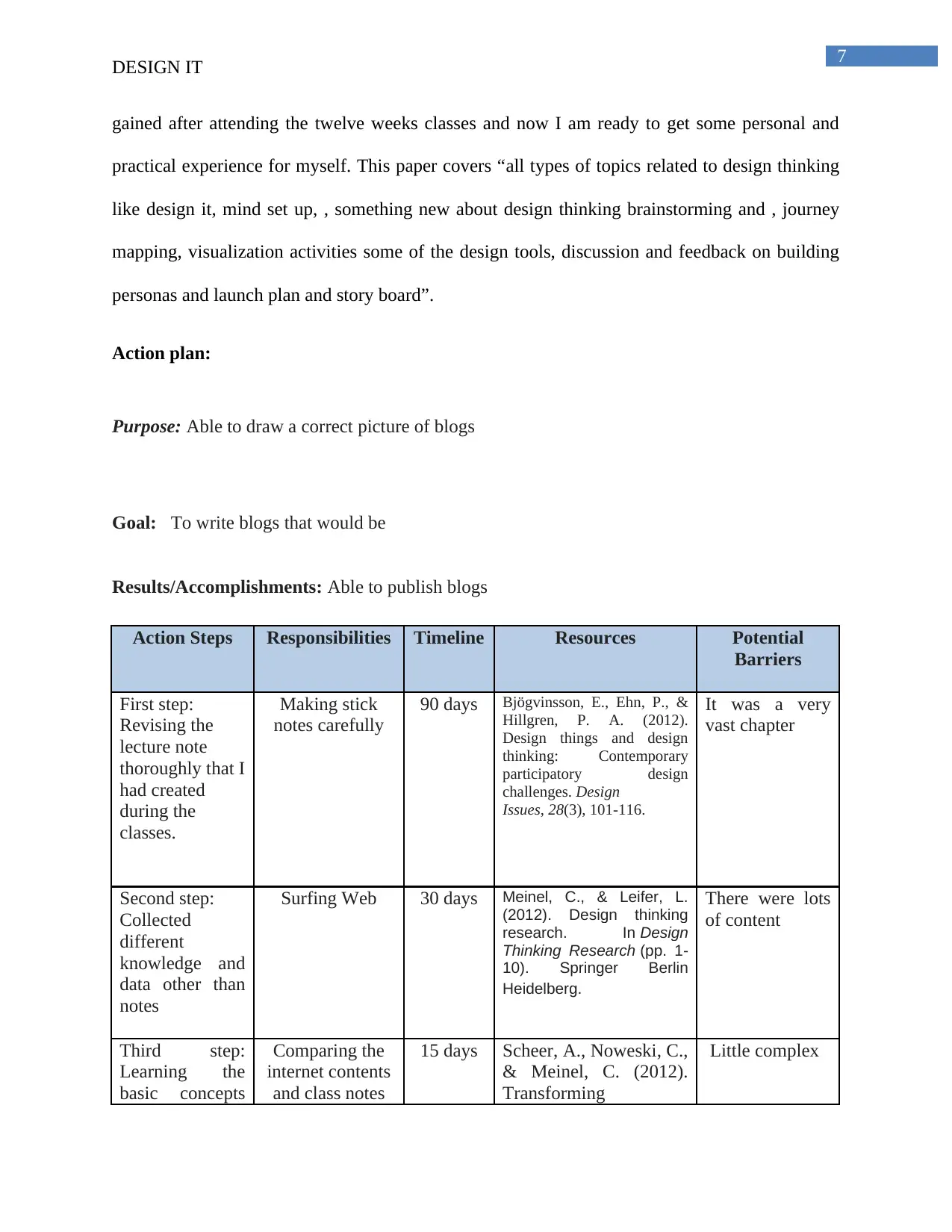
7
DESIGN IT
gained after attending the twelve weeks classes and now I am ready to get some personal and
practical experience for myself. This paper covers “all types of topics related to design thinking
like design it, mind set up, , something new about design thinking brainstorming and , journey
mapping, visualization activities some of the design tools, discussion and feedback on building
personas and launch plan and story board”.
Action plan:
Purpose: Able to draw a correct picture of blogs
Goal: To write blogs that would be
Results/Accomplishments: Able to publish blogs
Action Steps Responsibilities Timeline Resources Potential
Barriers
First step:
Revising the
lecture note
thoroughly that I
had created
during the
classes.
Making stick
notes carefully
90 days Bjögvinsson, E., Ehn, P., &
Hillgren, P. A. (2012).
Design things and design
thinking: Contemporary
participatory design
challenges. Design
Issues, 28(3), 101-116.
It was a very
vast chapter
Second step:
Collected
different
knowledge and
data other than
notes
Surfing Web 30 days Meinel, C., & Leifer, L.
(2012). Design thinking
research. In Design
Thinking Research (pp. 1-
10). Springer Berlin
Heidelberg.
There were lots
of content
Third step:
Learning the
basic concepts
Comparing the
internet contents
and class notes
15 days Scheer, A., Noweski, C.,
& Meinel, C. (2012).
Transforming
Little complex
DESIGN IT
gained after attending the twelve weeks classes and now I am ready to get some personal and
practical experience for myself. This paper covers “all types of topics related to design thinking
like design it, mind set up, , something new about design thinking brainstorming and , journey
mapping, visualization activities some of the design tools, discussion and feedback on building
personas and launch plan and story board”.
Action plan:
Purpose: Able to draw a correct picture of blogs
Goal: To write blogs that would be
Results/Accomplishments: Able to publish blogs
Action Steps Responsibilities Timeline Resources Potential
Barriers
First step:
Revising the
lecture note
thoroughly that I
had created
during the
classes.
Making stick
notes carefully
90 days Bjögvinsson, E., Ehn, P., &
Hillgren, P. A. (2012).
Design things and design
thinking: Contemporary
participatory design
challenges. Design
Issues, 28(3), 101-116.
It was a very
vast chapter
Second step:
Collected
different
knowledge and
data other than
notes
Surfing Web 30 days Meinel, C., & Leifer, L.
(2012). Design thinking
research. In Design
Thinking Research (pp. 1-
10). Springer Berlin
Heidelberg.
There were lots
of content
Third step:
Learning the
basic concepts
Comparing the
internet contents
and class notes
15 days Scheer, A., Noweski, C.,
& Meinel, C. (2012).
Transforming
Little complex
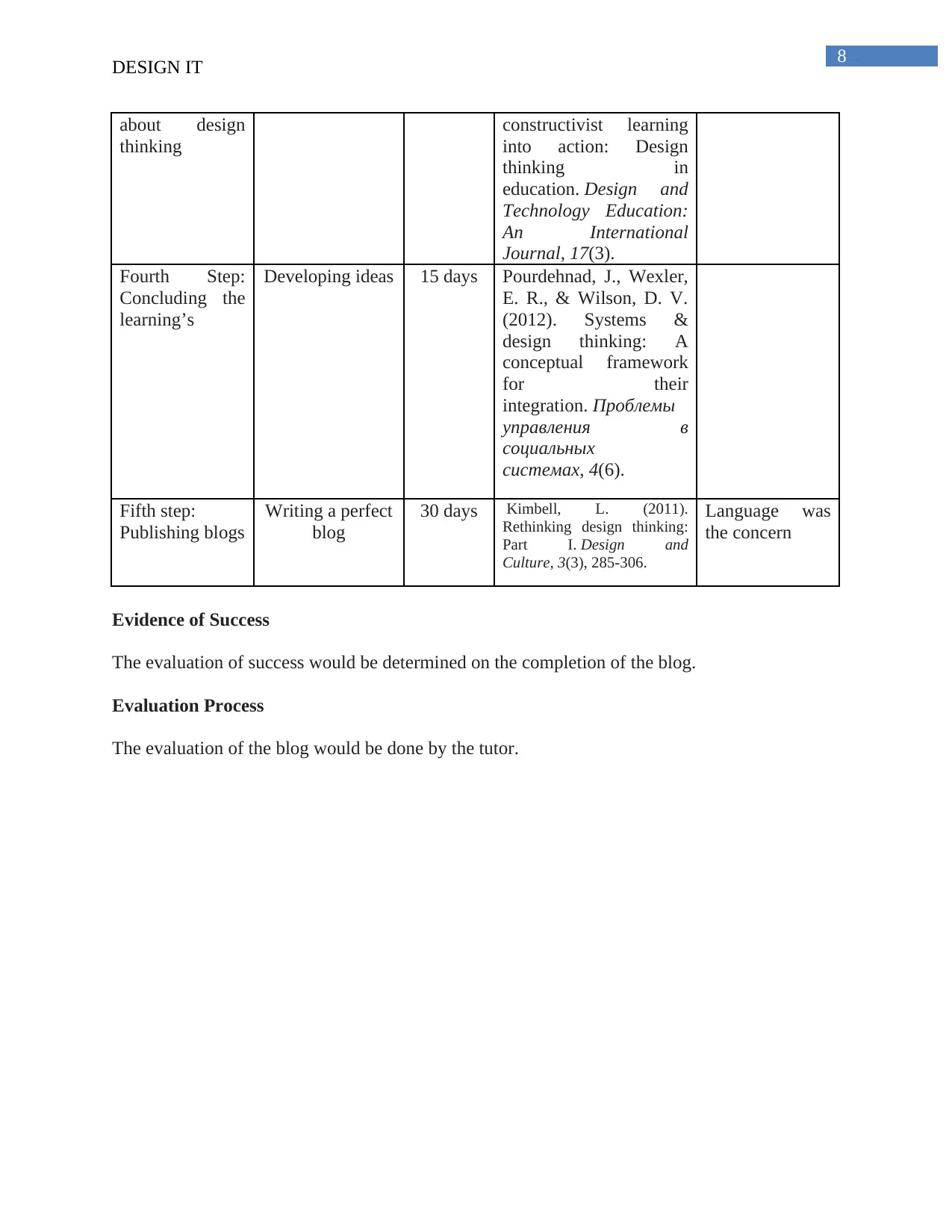
8
DESIGN IT
about design
thinking
constructivist learning
into action: Design
thinking in
education. Design and
Technology Education:
An International
Journal, 17(3).
Fourth Step:
Concluding the
learning’s
Developing ideas 15 days Pourdehnad, J., Wexler,
E. R., & Wilson, D. V.
(2012). Systems &
design thinking: A
conceptual framework
for their
integration. Проблемы
управления в
социальных
системах, 4(6).
Fifth step:
Publishing blogs
Writing a perfect
blog
30 days Kimbell, L. (2011).
Rethinking design thinking:
Part I. Design and
Culture, 3(3), 285-306.
Language was
the concern
Evidence of Success
The evaluation of success would be determined on the completion of the blog.
Evaluation Process
The evaluation of the blog would be done by the tutor.
DESIGN IT
about design
thinking
constructivist learning
into action: Design
thinking in
education. Design and
Technology Education:
An International
Journal, 17(3).
Fourth Step:
Concluding the
learning’s
Developing ideas 15 days Pourdehnad, J., Wexler,
E. R., & Wilson, D. V.
(2012). Systems &
design thinking: A
conceptual framework
for their
integration. Проблемы
управления в
социальных
системах, 4(6).
Fifth step:
Publishing blogs
Writing a perfect
blog
30 days Kimbell, L. (2011).
Rethinking design thinking:
Part I. Design and
Culture, 3(3), 285-306.
Language was
the concern
Evidence of Success
The evaluation of success would be determined on the completion of the blog.
Evaluation Process
The evaluation of the blog would be done by the tutor.
⊘ This is a preview!⊘
Do you want full access?
Subscribe today to unlock all pages.

Trusted by 1+ million students worldwide
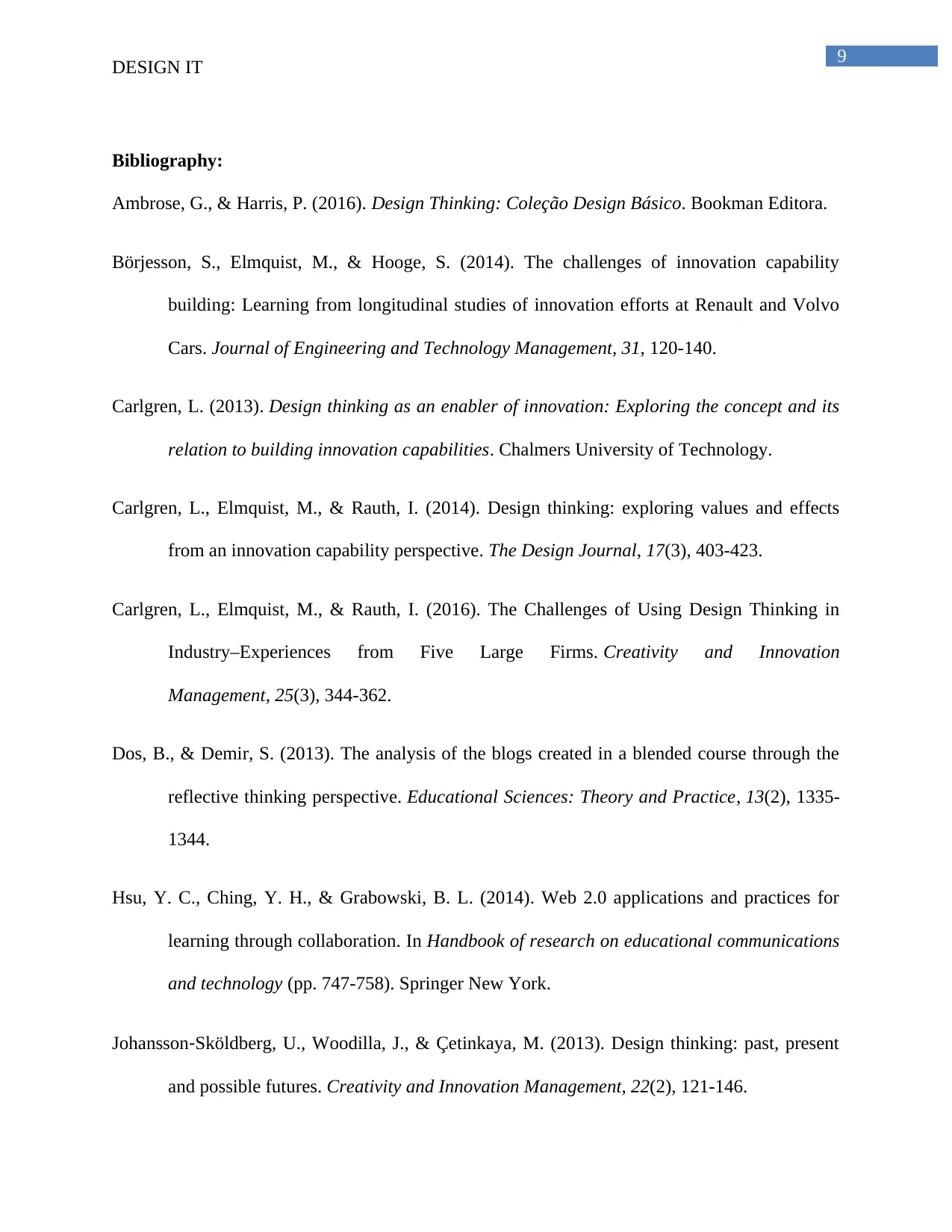
9
DESIGN IT
Bibliography:
Ambrose, G., & Harris, P. (2016). Design Thinking: Coleção Design Básico. Bookman Editora.
Börjesson, S., Elmquist, M., & Hooge, S. (2014). The challenges of innovation capability
building: Learning from longitudinal studies of innovation efforts at Renault and Volvo
Cars. Journal of Engineering and Technology Management, 31, 120-140.
Carlgren, L. (2013). Design thinking as an enabler of innovation: Exploring the concept and its
relation to building innovation capabilities. Chalmers University of Technology.
Carlgren, L., Elmquist, M., & Rauth, I. (2014). Design thinking: exploring values and effects
from an innovation capability perspective. The Design Journal, 17(3), 403-423.
Carlgren, L., Elmquist, M., & Rauth, I. (2016). The Challenges of Using Design Thinking in
Industry–Experiences from Five Large Firms. Creativity and Innovation
Management, 25(3), 344-362.
Dos, B., & Demir, S. (2013). The analysis of the blogs created in a blended course through the
reflective thinking perspective. Educational Sciences: Theory and Practice, 13(2), 1335-
1344.
Hsu, Y. C., Ching, Y. H., & Grabowski, B. L. (2014). Web 2.0 applications and practices for
learning through collaboration. In Handbook of research on educational communications
and technology (pp. 747-758). Springer New York.
Johansson‐Sköldberg, U., Woodilla, J., & Çetinkaya, M. (2013). Design thinking: past, present
and possible futures. Creativity and Innovation Management, 22(2), 121-146.
DESIGN IT
Bibliography:
Ambrose, G., & Harris, P. (2016). Design Thinking: Coleção Design Básico. Bookman Editora.
Börjesson, S., Elmquist, M., & Hooge, S. (2014). The challenges of innovation capability
building: Learning from longitudinal studies of innovation efforts at Renault and Volvo
Cars. Journal of Engineering and Technology Management, 31, 120-140.
Carlgren, L. (2013). Design thinking as an enabler of innovation: Exploring the concept and its
relation to building innovation capabilities. Chalmers University of Technology.
Carlgren, L., Elmquist, M., & Rauth, I. (2014). Design thinking: exploring values and effects
from an innovation capability perspective. The Design Journal, 17(3), 403-423.
Carlgren, L., Elmquist, M., & Rauth, I. (2016). The Challenges of Using Design Thinking in
Industry–Experiences from Five Large Firms. Creativity and Innovation
Management, 25(3), 344-362.
Dos, B., & Demir, S. (2013). The analysis of the blogs created in a blended course through the
reflective thinking perspective. Educational Sciences: Theory and Practice, 13(2), 1335-
1344.
Hsu, Y. C., Ching, Y. H., & Grabowski, B. L. (2014). Web 2.0 applications and practices for
learning through collaboration. In Handbook of research on educational communications
and technology (pp. 747-758). Springer New York.
Johansson‐Sköldberg, U., Woodilla, J., & Çetinkaya, M. (2013). Design thinking: past, present
and possible futures. Creativity and Innovation Management, 22(2), 121-146.
Paraphrase This Document
Need a fresh take? Get an instant paraphrase of this document with our AI Paraphraser
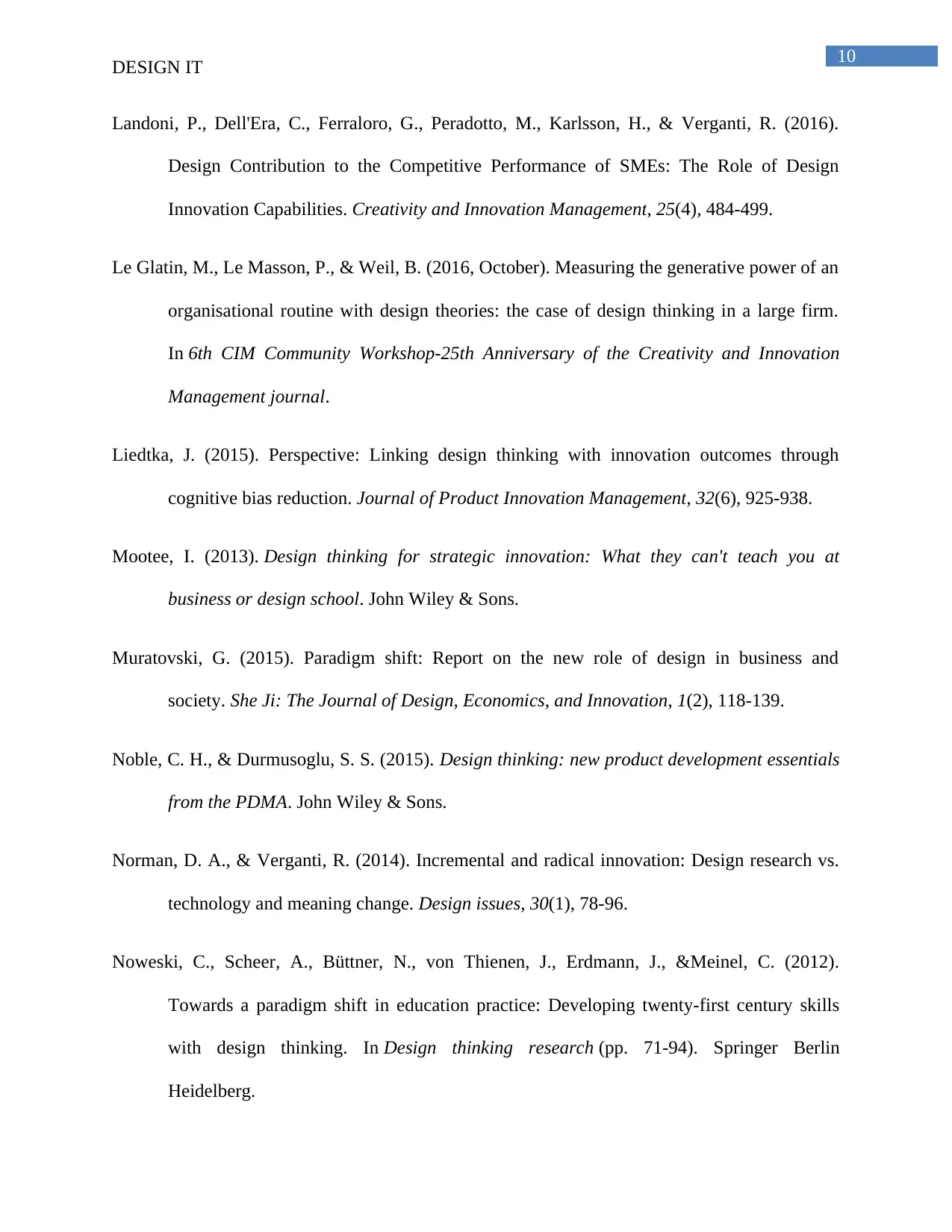
10
DESIGN IT
Landoni, P., Dell'Era, C., Ferraloro, G., Peradotto, M., Karlsson, H., & Verganti, R. (2016).
Design Contribution to the Competitive Performance of SMEs: The Role of Design
Innovation Capabilities. Creativity and Innovation Management, 25(4), 484-499.
Le Glatin, M., Le Masson, P., & Weil, B. (2016, October). Measuring the generative power of an
organisational routine with design theories: the case of design thinking in a large firm.
In 6th CIM Community Workshop-25th Anniversary of the Creativity and Innovation
Management journal.
Liedtka, J. (2015). Perspective: Linking design thinking with innovation outcomes through
cognitive bias reduction. Journal of Product Innovation Management, 32(6), 925-938.
Mootee, I. (2013). Design thinking for strategic innovation: What they can't teach you at
business or design school. John Wiley & Sons.
Muratovski, G. (2015). Paradigm shift: Report on the new role of design in business and
society. She Ji: The Journal of Design, Economics, and Innovation, 1(2), 118-139.
Noble, C. H., & Durmusoglu, S. S. (2015). Design thinking: new product development essentials
from the PDMA. John Wiley & Sons.
Norman, D. A., & Verganti, R. (2014). Incremental and radical innovation: Design research vs.
technology and meaning change. Design issues, 30(1), 78-96.
Noweski, C., Scheer, A., Büttner, N., von Thienen, J., Erdmann, J., &Meinel, C. (2012).
Towards a paradigm shift in education practice: Developing twenty-first century skills
with design thinking. In Design thinking research (pp. 71-94). Springer Berlin
Heidelberg.
DESIGN IT
Landoni, P., Dell'Era, C., Ferraloro, G., Peradotto, M., Karlsson, H., & Verganti, R. (2016).
Design Contribution to the Competitive Performance of SMEs: The Role of Design
Innovation Capabilities. Creativity and Innovation Management, 25(4), 484-499.
Le Glatin, M., Le Masson, P., & Weil, B. (2016, October). Measuring the generative power of an
organisational routine with design theories: the case of design thinking in a large firm.
In 6th CIM Community Workshop-25th Anniversary of the Creativity and Innovation
Management journal.
Liedtka, J. (2015). Perspective: Linking design thinking with innovation outcomes through
cognitive bias reduction. Journal of Product Innovation Management, 32(6), 925-938.
Mootee, I. (2013). Design thinking for strategic innovation: What they can't teach you at
business or design school. John Wiley & Sons.
Muratovski, G. (2015). Paradigm shift: Report on the new role of design in business and
society. She Ji: The Journal of Design, Economics, and Innovation, 1(2), 118-139.
Noble, C. H., & Durmusoglu, S. S. (2015). Design thinking: new product development essentials
from the PDMA. John Wiley & Sons.
Norman, D. A., & Verganti, R. (2014). Incremental and radical innovation: Design research vs.
technology and meaning change. Design issues, 30(1), 78-96.
Noweski, C., Scheer, A., Büttner, N., von Thienen, J., Erdmann, J., &Meinel, C. (2012).
Towards a paradigm shift in education practice: Developing twenty-first century skills
with design thinking. In Design thinking research (pp. 71-94). Springer Berlin
Heidelberg.
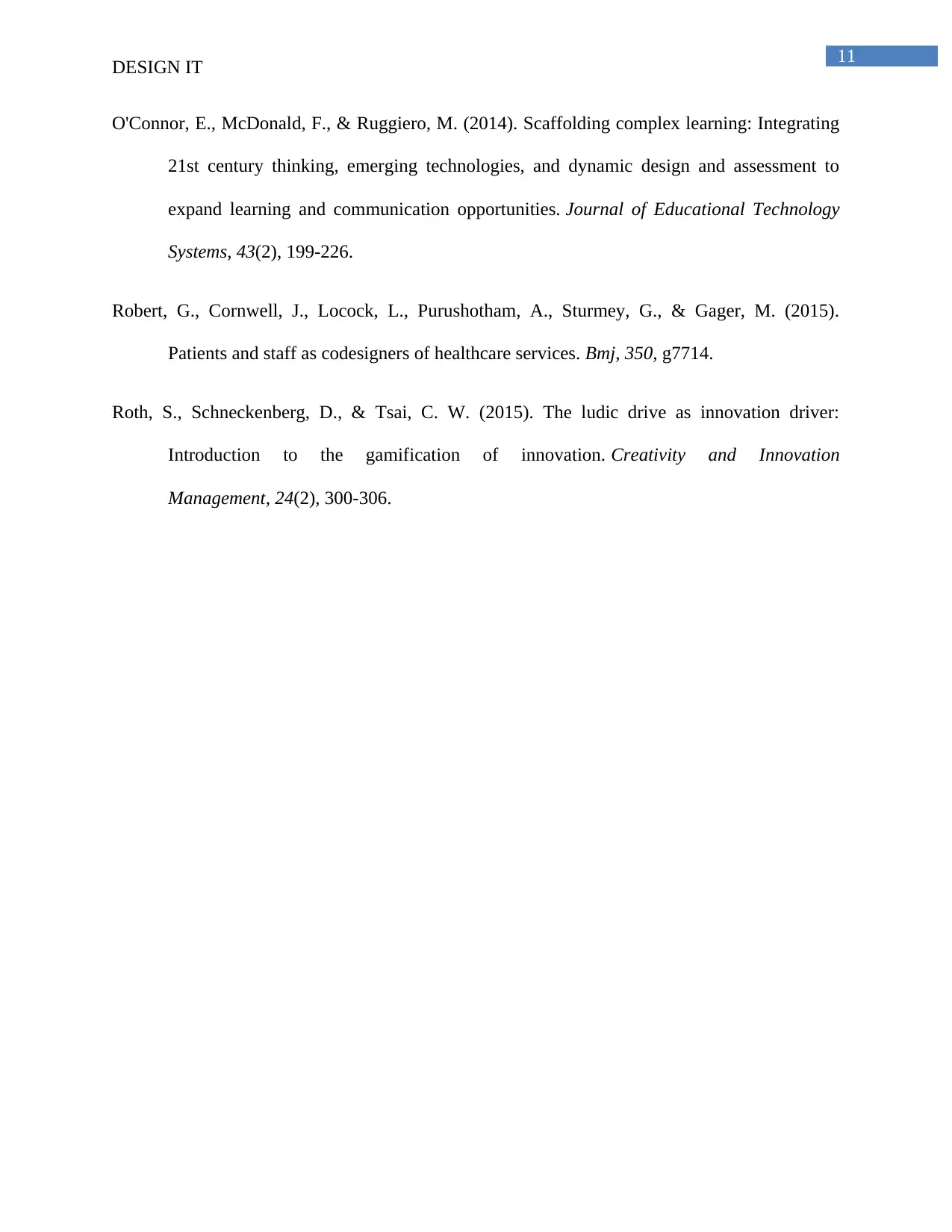
11
DESIGN IT
O'Connor, E., McDonald, F., & Ruggiero, M. (2014). Scaffolding complex learning: Integrating
21st century thinking, emerging technologies, and dynamic design and assessment to
expand learning and communication opportunities. Journal of Educational Technology
Systems, 43(2), 199-226.
Robert, G., Cornwell, J., Locock, L., Purushotham, A., Sturmey, G., & Gager, M. (2015).
Patients and staff as codesigners of healthcare services. Bmj, 350, g7714.
Roth, S., Schneckenberg, D., & Tsai, C. W. (2015). The ludic drive as innovation driver:
Introduction to the gamification of innovation. Creativity and Innovation
Management, 24(2), 300-306.
DESIGN IT
O'Connor, E., McDonald, F., & Ruggiero, M. (2014). Scaffolding complex learning: Integrating
21st century thinking, emerging technologies, and dynamic design and assessment to
expand learning and communication opportunities. Journal of Educational Technology
Systems, 43(2), 199-226.
Robert, G., Cornwell, J., Locock, L., Purushotham, A., Sturmey, G., & Gager, M. (2015).
Patients and staff as codesigners of healthcare services. Bmj, 350, g7714.
Roth, S., Schneckenberg, D., & Tsai, C. W. (2015). The ludic drive as innovation driver:
Introduction to the gamification of innovation. Creativity and Innovation
Management, 24(2), 300-306.
⊘ This is a preview!⊘
Do you want full access?
Subscribe today to unlock all pages.

Trusted by 1+ million students worldwide
1 out of 12
Related Documents
Your All-in-One AI-Powered Toolkit for Academic Success.
+13062052269
info@desklib.com
Available 24*7 on WhatsApp / Email
![[object Object]](/_next/static/media/star-bottom.7253800d.svg)
Unlock your academic potential
Copyright © 2020–2025 A2Z Services. All Rights Reserved. Developed and managed by ZUCOL.




